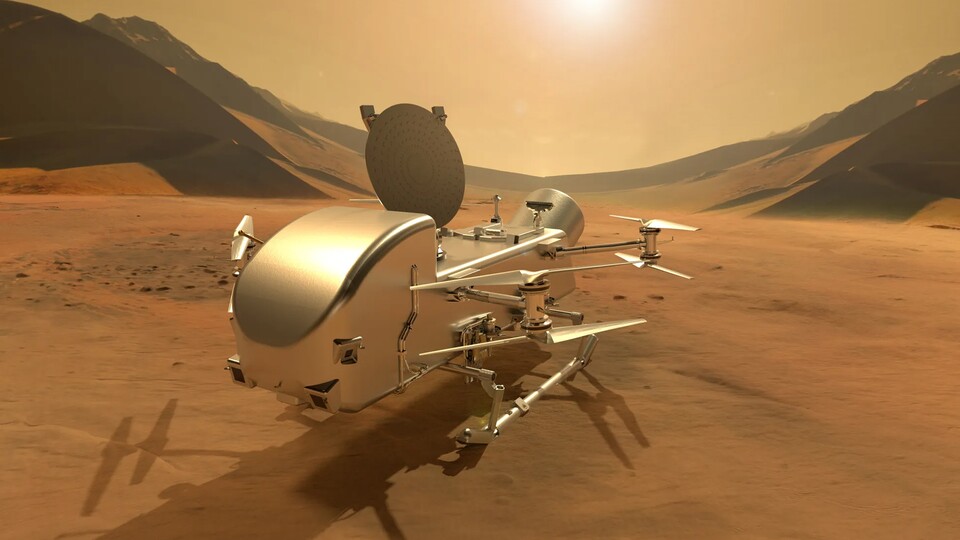
This is what the Dragonfly drone looks like. It will travel long distances over the surface of Titan's moon, collecting and analyzing samples. (Source: NASA/Johns Hopkins APL/Steve Gribben)
Advertisement
The Mars drone Ingenuity was actually only supposed to last 30 days. In the end she flew for an unbelievable 3 years and broke all records and standards by far.
On April 16, 2024, NASA confirmed in a notice: The successor – called Dragonfly – is launched into space with Saturn's moon Titan as the target. So the pioneer story continues.
Why we report on it: The Titan mission is considered particularly promising for learning more about the origin of life:
- NASA suspects chemical processes there that took place before life emerged on our home planet.
- Through this research we could gain knowledge about our own origin story.
This is what the Dragonfly looks like in action: In this Twitter post you can see the drone flying over the surface of Titan in an animation. She will be the first to fly laboratory
be on another celestial body according to NASA:
Advertisement
Link to Twitter content
In detail: The Titan mission has now been officially confirmed following a review. The start date is the year 2028 and the mission cost will be $3.35 billion (3.15 billion euros) amount to:
- This is twice the originally planned budget.
- The reason for this is the corona pandemic and a delay of two years.
- To compensate, a heavy-lift rocket is used to reduce flight duration
The goal of the Titan mission: The Dragonfly is a so-called rotary wing aircraft 2034 to arrive on Titan:
- NASA wants to use this to fly to promising locations on the moon.
- Analyzers inside the aircraft are intended to examine samples.
- In total 2 years The Dragonfly is supposed to collect data about the composition of the surface.
- At best they should prebiotic chemical processes be found and examined
Put simply: These chemical processes also used to take place on the young Earth. Scientists suspect that they provided the basis for the emergence of the first life forms. If the mission is a success, it could represent a research breakthrough in two ways:
- The mission could be flying
rover
advance with longer range like the Dragonfly. - Gather new knowledge about the origins of life on our Earth (and in space).
Video of the mission: NASA has created a 2-minute clip full of animations as you can imagine the Titan mission. There you can also see the different sensors that the scientists will use to examine the surface:
Link to YouTube content
Technical details of the Dragonfly mission and Saturn's moon Titan
The Dragonfly: This is NASA's first aircraft that will fly for scientific purposes on a celestial body other than Earth. The Ingenuity served as a feasibility study without laboratory equipment and showed the potential for this further development:
- The Dragonfly is a rotary wing aircraft with eight rotors.
- It works like a large drone.
- Advantage: The Dragonfly can travel further distances than any rover on the ground.
- Inside there are analytical devices for drilling samples.
Mission challenges:
- The temperatures are on the surface of Titan minus 180 degrees.
- A thick veil of haze permanently obscures the moon and leaves hardly any sunlight through.
- The Dragonfly therefore runs using a Radionuclide battery
The icy moon Titan: He is the greatest moon of the planet Saturn with a diameter of 5,150 km. Titan has a dense atmosphere consisting primarily of nitrogen. Because of the low temperatures, the surface is partially covered by lakes and rivers of liquid methane and ethane.
Can Titan be colonized?
In theory, Titan is very similar to Earth thanks to its atmosphere. There is an atmospheric pressure of around 1.5 times that of our home planet.
However, as mentioned above, the conditions are very hostile to life with low temperatures of up to minus 180 degrees. Also hits loud Xataka only 0.1 percent of sunlight of the Earth to the surface of Titan.
So it's unlikely that we'll find a second home there – but that shouldn't make it any less interesting in the eyes of science because of its prebiotic chemical processes.